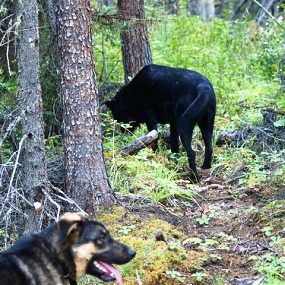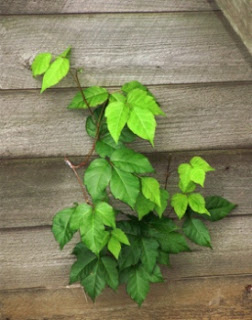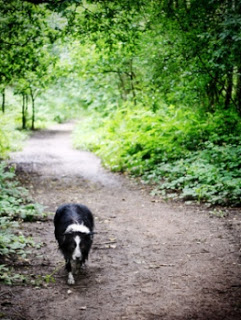Dogs
 By Linda Cole
By Linda Cole
Hiking a favorite trail or playing at the park may seem like a safe way to spend the day, but you may not have noticed that patch of poison ivy your dog walked through. The question is, does poison ivy, oak or sumac affect dogs, and can they give it to us?
Humans and animals can suffer the same itchy fate when exposed skin makes contact with poison ivy, oak or sumac. These plants aren't as likely to bother cats because their coat covers them completely. Dogs on the other hand, have exposed skin on their tummy and the inside area of their back legs. The oil from these plants can also sometimes work its way through a dog or cat's coat to the skin, causing an itchy discomfort. If you weren't aware your pet was in contact with one of these poison plants, you might think his scratching was due to fleas.
Poison ivy is generally found in every state except Hawaii and Alaska. Poison oak is mainly found in western states; it can be found in southern states as well, but is rarely found in the Midwest. Sumac thrives in wooded, swampy areas of southern and eastern states. It's also prevalent in wet wooded areas, like along the Mississippi River.
 All three toxic plants contain an oily sap called urushiol, which causes an itchy rash and nasty blisters on the skin. Urushiol has to be absorbed through the skin before it can cause an allergic reaction. It takes longer for the oily resin to penetrate through thicker skin, which is why there can be a delay before there's a reaction, or why it seems to spread. A rash and blisters are seen first where the skin is the thinnest, and appears on other areas as the toxin is absorbed through thicker skin. Fluid from broken blisters is not contagious and can't infect other areas on the body because the urushiol that created the blister has already been absorbed.
All three toxic plants contain an oily sap called urushiol, which causes an itchy rash and nasty blisters on the skin. Urushiol has to be absorbed through the skin before it can cause an allergic reaction. It takes longer for the oily resin to penetrate through thicker skin, which is why there can be a delay before there's a reaction, or why it seems to spread. A rash and blisters are seen first where the skin is the thinnest, and appears on other areas as the toxin is absorbed through thicker skin. Fluid from broken blisters is not contagious and can't infect other areas on the body because the urushiol that created the blister has already been absorbed.
If your dog or cat walks through a patch of poison ivy, oak or sumac and gets some of the resin on his coat, even if it doesn't affect him, you can get the sap on you if he rubs against you or you pet him. Since dogs and cats are shorter, it's very easy for them to get the oily sap on their ears, face or anywhere else on their body when hiking or just out running around in their own backyard.
Poison ivy, oak and sumac are fragile plants and are easy to break, which is how the oil is released. Urushiol is present in all parts of the plants. Dogs walking, rolling or running through a patch can get it on their tummy, on the underside of their back legs and on their coat. A reaction can be mild to severe.
We use calamine (Caladryl) lotion to ease our discomfort. However, it can be toxic to pets if they lick it because it has zinc oxide in it, so it's not recommended for use on dogs and cats. It's best to take your pet to the vet. He may need prescription medication to reduce inflammation and itching.
 You can minimize the effects of the toxin on you or your pet by washing it off immediately with soap and warm water. The oily sap can't produce a rash if it isn't allowed to soak into the skin. It usually takes at least two washings (three is best), to get all of the urushiol washed off your pet. During and after the first washing, try not to let your pet shake because he can transfer some of the oil to you. Wear gloves, a long sleeve shirt and pants to lessen the chance of getting some of the oil on your skin. If you use a towel to dry your pet off, be sure to wash it before using it again. The toxin can be spread to you from clothing, shoes or tools that have been in contact with it.
You can minimize the effects of the toxin on you or your pet by washing it off immediately with soap and warm water. The oily sap can't produce a rash if it isn't allowed to soak into the skin. It usually takes at least two washings (three is best), to get all of the urushiol washed off your pet. During and after the first washing, try not to let your pet shake because he can transfer some of the oil to you. Wear gloves, a long sleeve shirt and pants to lessen the chance of getting some of the oil on your skin. If you use a towel to dry your pet off, be sure to wash it before using it again. The toxin can be spread to you from clothing, shoes or tools that have been in contact with it.
Sometimes a dog or cat will eat some of the plant. As long as they don't eat a lot, it's usually not a problem, but some pets can have an adverse reaction. Watch for vomiting or diarrhea, and if you think your pet ate some poison ivy, oak or sumac and is having a reaction to it, call your vet as soon as possible.
From our perspective, poison ivy, oak and sumac are nuisance plants that can adversely affect our pets and us, but they are important for wildlife. Crows, bluebirds, turkeys, raccoons, rabbits and deer eat the berry-like fruit on the plant, and the Northern Cardinal and American Goldfinch use threads from the plant to build their nests. Your best protection is to learn how to identify each plant, and give them a wide berth when you see them.
Top photo by Bruce McKay
Middle photo by Robert Brenner
Bottom photo by Dan Foy
Read more articles by Linda Cole
- Are Your Home And Yard Free From Poisons?
By Linda Cole March is poison prevention month, and it's a reminder to reflect on what you have planted in your yard, and what you have stored in the garage, basement and around the home. It's also a good time to think before you plant dangerous...
- Garden Plants That Repel Ticks
By Linda Cole Garden plants are a safe and natural way to control fleas and mosquitoes, but they can also be used to help repel ticks and keep tick carrying animals, like deer, out of your yard. I'd like to thank Frankie Furter, a very handsome black...
- Venomous Creatures That Can Endanger Pets
By Ruthie Bently There are many creatures in the United States (both native and non-native) that are venomous to our family pets. They can be found at the beach, in the woods, on a hike, even in your own backyard. This article will help to give you a...
- Grass, Weeds And Plants Pets Should Not Eat
By Linda Cole Cats and dogs who wander outside during the warmer months will always find something to nibble on. Some may chew on a weed or piece of grass because it tastes good. It doesn't harm them to eat certain plants, but some vegetation is...
- Itchy Skin On Dogs
The problem of itchy skin in dogs is caused due to different dog health problems. Diseases caused due to these problems can give you a hard time in maintaining the skin and coat of your pet dog. Itchy dog skin can also get quite troublesome for the...
Dogs
Does Poison Ivy, Oak and Sumac Affect Dogs?

Hiking a favorite trail or playing at the park may seem like a safe way to spend the day, but you may not have noticed that patch of poison ivy your dog walked through. The question is, does poison ivy, oak or sumac affect dogs, and can they give it to us?
Humans and animals can suffer the same itchy fate when exposed skin makes contact with poison ivy, oak or sumac. These plants aren't as likely to bother cats because their coat covers them completely. Dogs on the other hand, have exposed skin on their tummy and the inside area of their back legs. The oil from these plants can also sometimes work its way through a dog or cat's coat to the skin, causing an itchy discomfort. If you weren't aware your pet was in contact with one of these poison plants, you might think his scratching was due to fleas.
Poison ivy is generally found in every state except Hawaii and Alaska. Poison oak is mainly found in western states; it can be found in southern states as well, but is rarely found in the Midwest. Sumac thrives in wooded, swampy areas of southern and eastern states. It's also prevalent in wet wooded areas, like along the Mississippi River.
 All three toxic plants contain an oily sap called urushiol, which causes an itchy rash and nasty blisters on the skin. Urushiol has to be absorbed through the skin before it can cause an allergic reaction. It takes longer for the oily resin to penetrate through thicker skin, which is why there can be a delay before there's a reaction, or why it seems to spread. A rash and blisters are seen first where the skin is the thinnest, and appears on other areas as the toxin is absorbed through thicker skin. Fluid from broken blisters is not contagious and can't infect other areas on the body because the urushiol that created the blister has already been absorbed.
All three toxic plants contain an oily sap called urushiol, which causes an itchy rash and nasty blisters on the skin. Urushiol has to be absorbed through the skin before it can cause an allergic reaction. It takes longer for the oily resin to penetrate through thicker skin, which is why there can be a delay before there's a reaction, or why it seems to spread. A rash and blisters are seen first where the skin is the thinnest, and appears on other areas as the toxin is absorbed through thicker skin. Fluid from broken blisters is not contagious and can't infect other areas on the body because the urushiol that created the blister has already been absorbed.If your dog or cat walks through a patch of poison ivy, oak or sumac and gets some of the resin on his coat, even if it doesn't affect him, you can get the sap on you if he rubs against you or you pet him. Since dogs and cats are shorter, it's very easy for them to get the oily sap on their ears, face or anywhere else on their body when hiking or just out running around in their own backyard.
Poison ivy, oak and sumac are fragile plants and are easy to break, which is how the oil is released. Urushiol is present in all parts of the plants. Dogs walking, rolling or running through a patch can get it on their tummy, on the underside of their back legs and on their coat. A reaction can be mild to severe.
We use calamine (Caladryl) lotion to ease our discomfort. However, it can be toxic to pets if they lick it because it has zinc oxide in it, so it's not recommended for use on dogs and cats. It's best to take your pet to the vet. He may need prescription medication to reduce inflammation and itching.

Sometimes a dog or cat will eat some of the plant. As long as they don't eat a lot, it's usually not a problem, but some pets can have an adverse reaction. Watch for vomiting or diarrhea, and if you think your pet ate some poison ivy, oak or sumac and is having a reaction to it, call your vet as soon as possible.
From our perspective, poison ivy, oak and sumac are nuisance plants that can adversely affect our pets and us, but they are important for wildlife. Crows, bluebirds, turkeys, raccoons, rabbits and deer eat the berry-like fruit on the plant, and the Northern Cardinal and American Goldfinch use threads from the plant to build their nests. Your best protection is to learn how to identify each plant, and give them a wide berth when you see them.
Top photo by Bruce McKay
Middle photo by Robert Brenner
Bottom photo by Dan Foy
Read more articles by Linda Cole
- Are Your Home And Yard Free From Poisons?
By Linda Cole March is poison prevention month, and it's a reminder to reflect on what you have planted in your yard, and what you have stored in the garage, basement and around the home. It's also a good time to think before you plant dangerous...
- Garden Plants That Repel Ticks
By Linda Cole Garden plants are a safe and natural way to control fleas and mosquitoes, but they can also be used to help repel ticks and keep tick carrying animals, like deer, out of your yard. I'd like to thank Frankie Furter, a very handsome black...
- Venomous Creatures That Can Endanger Pets
By Ruthie Bently There are many creatures in the United States (both native and non-native) that are venomous to our family pets. They can be found at the beach, in the woods, on a hike, even in your own backyard. This article will help to give you a...
- Grass, Weeds And Plants Pets Should Not Eat
By Linda Cole Cats and dogs who wander outside during the warmer months will always find something to nibble on. Some may chew on a weed or piece of grass because it tastes good. It doesn't harm them to eat certain plants, but some vegetation is...
- Itchy Skin On Dogs
The problem of itchy skin in dogs is caused due to different dog health problems. Diseases caused due to these problems can give you a hard time in maintaining the skin and coat of your pet dog. Itchy dog skin can also get quite troublesome for the...
